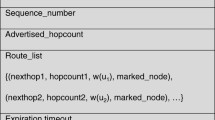Abstract
In multipath routing of wireless sensor network (WSN), greedy path selection is always prone to cause path oscillation (frequent path changes) between each couple of sensor and sink nodes. To alleviate the side effect, we propose an adaptive path selection model (called a WSN path selection model based on the adaptive response by attractor selection (ARAS) model (WARAS)) inspired by metabolism behaviors of Escherichia Coli. The model consists of two main features. The first one is a new formula for a parameter called path-activity used to indicate adaptation goodness of multipath traffic transmission in dynamic network environments, which is inversely proportional to absolute value of difference between current path quality and best path quality. The second one is a novel attractor expression for attractors of multi-attractor equations to concretely specify stochastic effect of noise items in the equations on the path selection. Then, in an experimental WSN scenario composed of many source nodes and their shared neighbor nodes, we validate a dynamic-adaptive selection characteristic of the WARAS on distributing loads of the neighbor nodes. Subsequently, we design a path quality probe scheme in a multipath ad hoc on-demand distance vector routing (AODV) protocol. Compared with the greedy path selection through the path quality probe scheme, simulation results show the WARAS can perform better on reducing network delay and the path oscillation.
创新点
在无线传感器网络(WSN)多路径路由中, 贪婪路径选择总是易于引发频繁的路径振荡。为了缓解此负面效果, 受大肠杆菌新陈代谢行为启发, 本文提出了一个适应的 WSN 多路径选择模型(WARAS)。此模型主要包括两个特色。首先是一个新的路径活跃度(path-activity)公式, 指明多路径传输对动态网络环境的适应优度。其次是一个新的吸引子表达式, 被首次推导为一个含有噪声项的表达式。在一个多路径AODV协议中, 一个实时多路径质量感知方案被设计。基于此方案, 仿真结果显示WARAS比贪婪选择更能降低网络延迟和路径振荡。
Similar content being viewed by others
References
Macit M, Gungor V C, Tuna G. Comparison of QoS-aware single-path vs. multi-path routing protocols for image transmission in wireless multimedia sensor networks. Ad Hoc Netw, 2014, 19: 132–141
Li W S, Tsai C W, Chen M, et al. Threshold behavior of multi-path random key pre-distribution for sparse wireless sensor networks. Math Comput Model, 2013, 57: 2776–2787
Liu A F, Zheng Z M, Zhang C, et al. Secure and energy-efficient disjoint multipath routing for WSNs. IEEE Trans Veh Technol, 2012, 61: 3255–3265
Liu A, Ren J, Li X, et al. Design principles and improvement of cost function based energy aware routing algorithms for wireless sensor networks. Comput Netw, 2012, 56: 1951–1967
Hong Y, Kim D, Li D, et al. Two new multipath routing algorithms for fault-tolerant communications in smart grid. Ad Hoc Netw, 2014, 22: 3–12
He S B, Li X, Chen J M, et al. EMD: energy-efficient delay-tolerant P2P message dissemination in wireless sensor and actor networks. IEEE J Sel Area Commun, 2013, 31: 75–84
Leibnitz K, Wakamiya N, Murata M. Biologically inspired adaptive multi-path routing in overlay networks. Commun ACM, 2006, 49: 62–67
Kashiwagi A, Urabe I, Kaneko K, et al. Adaptive response of a gene network to environmental changes by fitnessinduced attractor selection. PLoS ONE, 2006, 1: e49
Borges V C M, Curado M, Monteiro E. Cross-layer routing metrics for mesh networks: current status and research directions. Comput Commun, 2011, 34: 681–703
Garroppo R G, Giordano S, Tavanti L. A joint experimental and simulation study of the IEEE 802.11s HWMP protocol and airtime link metric. J Commun Syst, 2012, 25: 92–110
Zhang J, Hu Z Y, Zhang T. Update chain-based approach for checking route oscillation of BGP. Chin J Aeronaut, 2011, 24: 202–209
Jose M C, Alberto G M, Marcelo B, et al. BGP-XM: BGP extended multipath for transit autonomous systems. Comput Netw, 2013, 57: 954–975
Guo L. LSSP: a novel local segment-shared protection for multi-domain optical mesh networks. Comput Commun, 2007, 30: 1794–1801
Leibnitz K, Wakamiya N, Murata M. Resilient multi-path routing based on a biological attractor selection scheme. In: Proceedings of the 2nd International Workshop on Biologically Inspired Approaches to Advanced Information Technology, Osaka, 2006
Sakhaee E, Leibnitz K, Wakamiya N, et al. Layered attractor selection for clustering and data gathering in wireless sensor networks. In: Proceedings of IEEE Wireless Communications and Networking Conference, Sydney, 2010. 1–6
He S B, Chen J M, Yau D K Y, et al. Cross-layer optimization of correlated data gathering in wireless sensor networks. IEEE Trans Mob Comput, 2012, 11: 1678–1691
Motoyoshi G, Leibnitz K, Murata M. Proposal and evaluation of a future mobile network management mechanism with attractor selection. J Wirel Commun Netw, 2012, 259: 1–13
Iwai T, Wakamiya N, Murata M. Error-tolerant and energy-efficient coverage control based on biological attractor selection model in wireless sensor networks. Int J Distrib Sens Netw, 2012, 2012: 971014
Dong M, Ota K, Li H, et al. RENDEZVOUS: towards fast event detecting in wireless sensor and actor networks. Computing, 2014, 96: 995–1010
Author information
Authors and Affiliations
Corresponding author
Rights and permissions
About this article
Cite this article
Gong, W., Yang, X., Zhang, M. et al. An adaptive path selection model for WSN multipath routing inspired by metabolism behaviors. Sci. China Inf. Sci. 58, 1–15 (2015). https://doi.org/10.1007/s11432-015-5324-8
Received:
Accepted:
Published:
Issue Date:
DOI: https://doi.org/10.1007/s11432-015-5324-8




